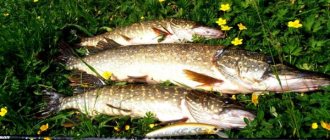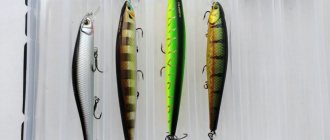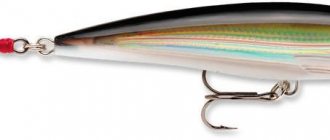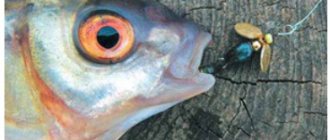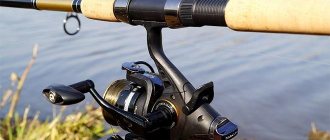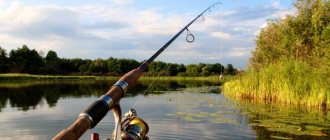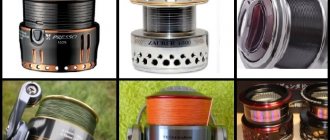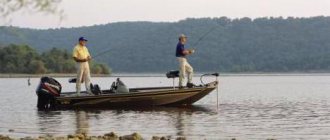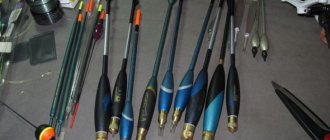Twitching technique
Twitching is a technique of fishing with minnows, which is characterized by jerky animation. This means catching pike with a special wobbler. In this case, the tip of the rod produces rhythmic, medium-strong twitches. But, despite the fact that the technique itself is quite simple, there are some nuances that will have to be taken into account. You may be interested in an article devoted to the features of twitching fishing.
We also recommend reading:
Model range of Salmo wobblers and Salmo Hornet catalog Spinner for pike - 10 best and how to make it yourself? Features of catching pike on girders in winter and summer Attractant for predatory fish: bait for pike perch, pike perch
So if you drive the wobbler monotonously, the pike will not be interested. But as soon as the game starts, the fish bite almost immediately. This means that jerk wiring in this case is the only key to success!
Wobbler minnow Owner Cultiva Rip'n minnow 112 SP
Another veteran of the large minnow class, who has been behind enemy lines more than once and returned victorious. The fairly wide and voluminous body shape of the minnow Owner Cultiva Rip'n minnow 112 SP wobbler provides a very expressive amplitude play in the horizontal plane. And after each sharp pull with the spinning rod, a powerful transverse vibration is added. Considering this feature, it is best to drive this wobbler not by sharp twitching, but by smooth pulls with sharp accelerations. This is necessary so that the minnow Owner Cultiva Rip'n minnow 112 SP wobbler starts up, as it shows its best qualities only at high speed. But the speed, naturally, should not be constant; this is why pauses in the wiring are needed.
By the way, most pike bites occur during pauses. The wobbler is balanced quite well and when reeling after a pull, it most often takes a clear horizontal position and begins to slowly sink, despite the fact that it is suspended. Which obviously suits the taste of the pike who noticed it from afar. It is precisely attracting pike from a long distance that is its key highlight. The weight of 21 g and the casting stabilization system allow this wobbler to fly very far, and its outstanding game attracts pike. The main thing is not to overdo it with speed; the stretches should be powerful, but not very frequent and long. You can add a few additional touches to the wiring, for example, after a series of two or three pulls, make a short jerk with the tip of the spinning rod. This will give the minnow Owner Cultiva Rip'n minnow 112 SP wobbler a slight impulse, which can serve as a signal for the pike pursuing it. This trick is not unique to this wobbler and can be applied to other wobblers. The minnow Owner Cultiva Rip'n minnow 112 SP wobbler is equipped with powerful Owner hooks of the ST-46 series.
Types of bites
When fishing for pike with a minnow, there are 3 types of bites:
- The first type is jig. The feeling is very similar to fishing with a jig. The minnow is practically in one place, the slack in the fishing line is reeled in, and with a second’s deceleration a slight push is noted. In this case, it is important to carry out immediate cutting. Read more about this technique in the article “Jig fishing: installation features, choice of bait.” Catching active pike occurs with a distinct jerk. The line is taut. It is best to take a bright fishing line - white, pink or yellow.
- The third type is the absence of a bite. At the same time, you jerk the minnow and suddenly notice that the fish is already on the hook.
Wobbler minnow Megabass Lates 120
Despite the same size as the previous wobbler model, these are radically different wobblers. Its body shape is much wider, so the wobbler looks much larger. In general, this is a fundamentally different wobbler, unlike the X-120, naturally not only in shape, but also in play, behavior in water and area of application. But the minnow Megabass Lates 120 is no less original wobbler than the X-120. Its main feature is that it is a strong-floating, shallow-water minnow with a high-mounted body. Due to this, after deepening, the wobbler begins to rise very quickly to the surface, creating a “roll” movement, that is, the movement of the wobbler’s body in a vertical plane. And those same movements are always held in high esteem by pike. Another feature of this minnow Megabass Lates 120 wobbler is that its working horizon can vary quite a lot depending on the wiring style. Driving it, for example, with hard twitching (short but sharp jerks) with pauses, the wobbler will go just under the surface, sometimes even slurping like a popper. This can be useful in shallow waters with grass on the bottom and a small area of clean water. The wobbler, due to its body shape, is very saily, and casting it in calm weather causes some problems. But when the wind picks up, it will outplay many of the longest-range wobblers. And due to a very active game, it will attract pike throughout its entire journey.
But, using smoother stretches, almost without pauses, it can be driven to a meter depth. An important detail of this minnow Megabass Lates 120 wobbler is its powerful acoustic system, which serves as an additional irritant for pike. The wobbler is equipped with three powerful hooks with external barbs.
Gallery: minnow wobblers (25 photos)
Stop and Go
It is believed that this wiring is one of the simplest intermittent animation techniques.
And, following the logic, this wiring can be placed on the same level as the uniform wiring. However, there are certain difficulties here. First of all, it is necessary to clearly understand the conditions and circumstances when this wiring will be most justified. There are times when “stop and go” wiring shows good results with floating fat geometry cranks. But still, the main type of wobblers for this technique are shads, minnows and transitional forms between them, neutral buoyancy with a working horizon of a meter or more.
There are only two cases when posting a stop and go is most justified:
- Cold water , characteristic of late autumn. Here everything happens on the edges and small differences in depth. Wobblers are small playing models with weak positive buoyancy. The bait is cast at a very low speed and quite long stops every few meters. The fish attacks the bait in most cases in the middle of the pause.
- Very warm water , accompanied by temperature stratification - a thermocline. Deep-water wobblers with neutral buoyancy are relevant here. The main fish are pike perch and pike.
The stop and go method has proven itself well when fishing for pike on toadfish. The most interesting thing here is that it is not a pure method, but something transitional between stop and go and twitching. That is, the wobbler is held evenly for some distance, pause, twitch, and start again.
Rating of the best budget wobblers from 6 popular brands.
A guide with a detailed classification of wobblers by depth, buoyancy and body shape.
Rating of pike wobblers – we choose them for a wide variety of fishing conditions.
The important role of pause
If you conduct any wobbler with uniform wiring, then it goes in a straight line without any deviations. If you add a few light pulls to this wiring, you will get a weakly expressed walker “walking the dog” and the wobbler will begin to deviate left and right. In this case, the result is a mixture of styles, which sometimes shows the best results.
But in this case, it is important to make a pause of sufficient length between the end of the previous jerk and the beginning of the next one. This is important to do to avoid the most common mistake - too short a pause. If during summer fishing for perch with jerking wobblers it is useful to exclude a pause, then in all other cases it should be at least minimal. When fishing for pike, it happens that increasing the pause, say, from two seconds to three or four, has a positive effect and there are significantly more bites.
In this case, a logical question arises: what will happen if a bite occurs during a long pause and goes unnoticed? This problem exists, but its importance is greatly exaggerated. After all, suspended wobblers belong to a fairly expensive class of baits and they have tees of excellent quality. This means that the probability of self-notching is very high. This is further evidenced by the fact that, for example, pike very often attacks with a turn. In addition, you can notice the moment of a bite by the trembling line or by its sliding to the side.
You shouldn’t keep the line taut during a pause, as is done in a jig, especially in the wind. In this case, the wobbler does not remain in place, but moves due to the arc blown by the wind. And if a predator is not currently inclined to attack a moving, albeit slowly, bait, then this fact will negatively affect the number of bites.
It must be remembered that the predator’s mood changes. And even during a successive series of fishing trips in one body of water, the fish’s interest in the behavior of the bait manifests itself in relation to the duration of the pauses. Therefore, it is important to be able to quickly adapt and the first thing to do is to change the wiring pattern due to pauses. In this case, the fishing speed is reduced, but there is a possibility that it is not required - the fish has not gone anywhere and is standing somewhere nearby. But today she is less aggressive and requires coaxing, including increasing pauses in the jerk drive.
Twitching minnow wobblers
Twitching is a specific fishing technique, the characteristic element of which is jerking with a rod. This method of wiring has been used by fishermen for a long time, but the term itself has come into use relatively recently.
The twitching technique is nothing more than a series of jerks of different amplitudes. The game of the minnow wobbler turns out to be quite active and variable, and therefore often provokes even well-fed and cautious predators to attack.
To master the twitching technique of fishing with minnow wobblers, you need to practice for some time. In addition, you will need special gear, which we will talk about a little later.
So, the main action of a fisherman when twitching is jerking with a spinning rod, which is carried out only through movements of the hand, and not the entire arm. Frequently flapping your entire arm is not only inconvenient, but also more tiring.
Depending on the actions of the fisherman, there are 3 options for twitching minnows:
- chaotic, when all movements are performed absolutely arbitrarily;
- monotonous, involving a simple alternation of jerks and pauses;
- rhythmic, when all movements and pauses are carried out systematically, according to a certain pattern.
As a rule, the predator attacks wobblers during the pause stage. Thus, perch often reacts to very sharp and intense movements of the bait with short pauses.
Jerking movements with longer pauses (4-6 s) attract the attention of the pike.
Sluggish, passive fish can sometimes be too lazy to attack too fast wobblers, and therefore in this case the pauses should be longer.
Before fishing, you should try the twitching technique in shallow water with more or less clear water in order to get a good look at the behavior of the bait. Pay attention to how the minnow behaves when jerking and, especially during the pause phase, whether the bait is really playing. After this, you can begin full twitching.
A very useful and interesting article on the topic: wobblers for pike
